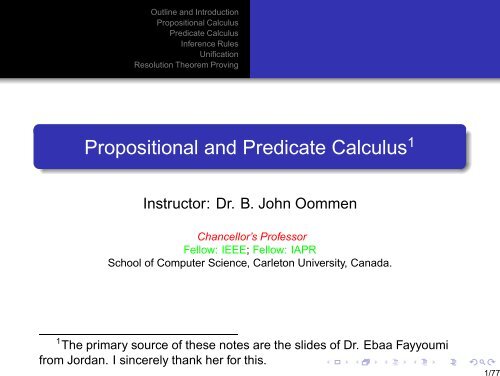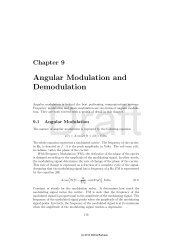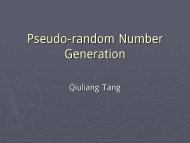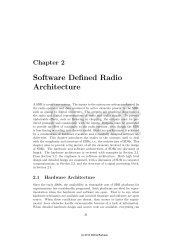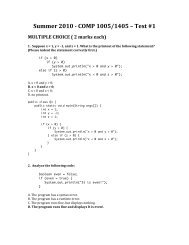Propositional and Predicate Calculus - Carleton University
Propositional and Predicate Calculus - Carleton University
Propositional and Predicate Calculus - Carleton University
You also want an ePaper? Increase the reach of your titles
YUMPU automatically turns print PDFs into web optimized ePapers that Google loves.
Outline <strong>and</strong> Introduction<br />
<strong>Propositional</strong> <strong>Calculus</strong><br />
<strong>Predicate</strong> <strong>Calculus</strong><br />
Inference Rules<br />
Unification<br />
Resolution Theorem Proving<br />
<strong>Propositional</strong> <strong>and</strong> <strong>Predicate</strong> <strong>Calculus</strong> 1<br />
Instructor: Dr. B. John Oommen<br />
Chancellor’s Professor<br />
Fellow: IEEE; Fellow: IAPR<br />
School of Computer Science, <strong>Carleton</strong> <strong>University</strong>, Canada.<br />
1 The primary source of these notes are the slides of Dr. Ebaa Fayyoumi<br />
from Jordan. I sincerely thank her for this.<br />
1/77
2/77<br />
Outline<br />
Outline <strong>and</strong> Introduction<br />
<strong>Propositional</strong> <strong>Calculus</strong><br />
<strong>Predicate</strong> <strong>Calculus</strong><br />
Inference Rules<br />
Unification<br />
Resolution Theorem Proving<br />
Outline<br />
Introduction<br />
Introduction<br />
<strong>Propositional</strong> <strong>Calculus</strong><br />
<strong>Predicate</strong> <strong>Calculus</strong><br />
Using Inference Rules to Produce <strong>Predicate</strong> <strong>Calculus</strong> Expressions<br />
Unification<br />
Clause Form<br />
Resolution <strong>and</strong> Theorem Proving
3/77<br />
Introduction<br />
Outline <strong>and</strong> Introduction<br />
<strong>Propositional</strong> <strong>Calculus</strong><br />
<strong>Predicate</strong> <strong>Calculus</strong><br />
Inference Rules<br />
Unification<br />
Resolution Theorem Proving<br />
Outline<br />
Introduction<br />
We will introduce the <strong>Propositional</strong> calculus <strong>and</strong> the language by which<br />
it is presented in AI<br />
We will explain the syntax <strong>and</strong> semantics of the <strong>Propositional</strong> <strong>and</strong><br />
<strong>Predicate</strong> calculus languages <strong>and</strong> the rules of inference
4/77<br />
Introduction<br />
Outline <strong>and</strong> Introduction<br />
<strong>Propositional</strong> <strong>Calculus</strong><br />
<strong>Predicate</strong> <strong>Calculus</strong><br />
Inference Rules<br />
Unification<br />
Resolution Theorem Proving<br />
Introduction<br />
<strong>Propositional</strong> Syntax<br />
<strong>Propositional</strong> Semantic<br />
Constructing New Logical Equivalence<br />
<strong>Propositional</strong> calculus uses Words, Phrases <strong>and</strong> Sentences to<br />
represent <strong>and</strong> reason about properties <strong>and</strong> relationships in the world<br />
Every Proposition has a truth value<br />
true (1)<br />
false (0)<br />
Examples of <strong>Propositional</strong> calculus:<br />
The moon is made of green cheese<br />
Open the door −→ X; Imperative.<br />
“What time is it” −→ X; Interrogative<br />
<strong>Propositional</strong> calculus consists of<br />
Syntax {Symbols <strong>and</strong> Sentences}<br />
Semantics
4/77<br />
Introduction<br />
Outline <strong>and</strong> Introduction<br />
<strong>Propositional</strong> <strong>Calculus</strong><br />
<strong>Predicate</strong> <strong>Calculus</strong><br />
Inference Rules<br />
Unification<br />
Resolution Theorem Proving<br />
Introduction<br />
<strong>Propositional</strong> Syntax<br />
<strong>Propositional</strong> Semantic<br />
Constructing New Logical Equivalence<br />
<strong>Propositional</strong> calculus uses Words, Phrases <strong>and</strong> Sentences to<br />
represent <strong>and</strong> reason about properties <strong>and</strong> relationships in the world<br />
Every Proposition has a truth value<br />
true (1)<br />
false (0)<br />
Examples of <strong>Propositional</strong> calculus:<br />
The moon is made of green cheese<br />
Open the door −→ X; Imperative.<br />
“What time is it” −→ X; Interrogative<br />
<strong>Propositional</strong> calculus consists of<br />
Syntax {Symbols <strong>and</strong> Sentences}<br />
Semantics
4/77<br />
Introduction<br />
Outline <strong>and</strong> Introduction<br />
<strong>Propositional</strong> <strong>Calculus</strong><br />
<strong>Predicate</strong> <strong>Calculus</strong><br />
Inference Rules<br />
Unification<br />
Resolution Theorem Proving<br />
Introduction<br />
<strong>Propositional</strong> Syntax<br />
<strong>Propositional</strong> Semantic<br />
Constructing New Logical Equivalence<br />
<strong>Propositional</strong> calculus uses Words, Phrases <strong>and</strong> Sentences to<br />
represent <strong>and</strong> reason about properties <strong>and</strong> relationships in the world<br />
Every Proposition has a truth value<br />
true (1)<br />
false (0)<br />
Examples of <strong>Propositional</strong> calculus:<br />
The moon is made of green cheese<br />
Open the door −→ X; Imperative.<br />
“What time is it” −→ X; Interrogative<br />
<strong>Propositional</strong> calculus consists of<br />
Syntax {Symbols <strong>and</strong> Sentences}<br />
Semantics
4/77<br />
Introduction<br />
Outline <strong>and</strong> Introduction<br />
<strong>Propositional</strong> <strong>Calculus</strong><br />
<strong>Predicate</strong> <strong>Calculus</strong><br />
Inference Rules<br />
Unification<br />
Resolution Theorem Proving<br />
Introduction<br />
<strong>Propositional</strong> Syntax<br />
<strong>Propositional</strong> Semantic<br />
Constructing New Logical Equivalence<br />
<strong>Propositional</strong> calculus uses Words, Phrases <strong>and</strong> Sentences to<br />
represent <strong>and</strong> reason about properties <strong>and</strong> relationships in the world<br />
Every Proposition has a truth value<br />
true (1)<br />
false (0)<br />
Examples of <strong>Propositional</strong> calculus:<br />
The moon is made of green cheese<br />
Open the door −→ X; Imperative.<br />
“What time is it” −→ X; Interrogative<br />
<strong>Propositional</strong> calculus consists of<br />
Syntax {Symbols <strong>and</strong> Sentences}<br />
Semantics
5/77<br />
Outline <strong>and</strong> Introduction<br />
<strong>Propositional</strong> <strong>Calculus</strong><br />
<strong>Predicate</strong> <strong>Calculus</strong><br />
Inference Rules<br />
Unification<br />
Resolution Theorem Proving<br />
<strong>Propositional</strong> Syntax<br />
Introduction<br />
<strong>Propositional</strong> Syntax<br />
<strong>Propositional</strong> Semantic<br />
Constructing New Logical Equivalence<br />
DEFINITION<br />
PROPOSITIONAL CALCULUS SYMBOLS<br />
The symbols of propositional calculus are the <strong>Propositional</strong> symbols:<br />
P, Q, R, S,...<br />
The Truth symbols:<br />
true, false<br />
And the Connectives:<br />
∧, ∨, ¬, →, ≡
6/77<br />
Outline <strong>and</strong> Introduction<br />
<strong>Propositional</strong> <strong>Calculus</strong><br />
<strong>Predicate</strong> <strong>Calculus</strong><br />
Inference Rules<br />
Unification<br />
Resolution Theorem Proving<br />
<strong>Propositional</strong> Syntax 1<br />
Introduction<br />
<strong>Propositional</strong> Syntax<br />
<strong>Propositional</strong> Semantic<br />
Constructing New Logical Equivalence<br />
DEFINITION<br />
PROPOSITIONAL CALCULUS SENTENCES<br />
Every propositional symbol <strong>and</strong> truth symbol is a sentence<br />
For example: true, P, Q, <strong>and</strong> R are sentences<br />
The negation of a sentence is a sentence<br />
For example: ¬P <strong>and</strong> ¬false are sentences<br />
The conjunction, or <strong>and</strong>, of two sentences is a sentence<br />
For example: P ∧¬P is a sentence
7/77<br />
Outline <strong>and</strong> Introduction<br />
<strong>Propositional</strong> <strong>Calculus</strong><br />
<strong>Predicate</strong> <strong>Calculus</strong><br />
Inference Rules<br />
Unification<br />
Resolution Theorem Proving<br />
<strong>Propositional</strong> Syntax 2<br />
Introduction<br />
<strong>Propositional</strong> Syntax<br />
<strong>Propositional</strong> Semantic<br />
Constructing New Logical Equivalence<br />
The disjunction, or or, of two sentences is a sentence<br />
For example: P ∨¬P is a sentence<br />
the implication of one sentence from another is a sentence<br />
For example: P → Q is a sentence<br />
The equivalence of two sentences is a sentence<br />
For example: P ∨ Q ≡ R is a sentence<br />
Legal sentences are also called well-formed formulae or WFFs
8/77<br />
Outline <strong>and</strong> Introduction<br />
<strong>Propositional</strong> <strong>Calculus</strong><br />
<strong>Predicate</strong> <strong>Calculus</strong><br />
Inference Rules<br />
Unification<br />
Resolution Theorem Proving<br />
<strong>Propositional</strong> Syntax 3<br />
Introduction<br />
<strong>Propositional</strong> Syntax<br />
<strong>Propositional</strong> Semantic<br />
Constructing New Logical Equivalence<br />
The expression of the form (P ∧ Q) (P <strong>and</strong> Q) is called a “Conjunct”<br />
The expression of the form (P ∨ Q) (P or Q) is called a “Disjunct”<br />
The expression of the form (P ⇒ Q) (P implies Q),<br />
P is the “premise” or “antecedent”<br />
Q is a “conclusion” or “consequent”
9/77<br />
Outline <strong>and</strong> Introduction<br />
<strong>Propositional</strong> <strong>Calculus</strong><br />
<strong>Predicate</strong> <strong>Calculus</strong><br />
Inference Rules<br />
Unification<br />
Resolution Theorem Proving<br />
<strong>Propositional</strong> Semantics 1<br />
Introduction<br />
<strong>Propositional</strong> Syntax<br />
<strong>Propositional</strong> Semantic<br />
Constructing New Logical Equivalence<br />
DEFINITION<br />
PROPOSITIONAL CALCULUS SEMANTICS<br />
An interpretation of a set of propositions is the assignment of a truth value,<br />
either T or F, to each propositional symbol<br />
The symbol true is always assigned the value T, <strong>and</strong> the symbol false is<br />
assigned F<br />
The interpretation or truth value for sentences is determined by:<br />
The truth assignment of negation,¬P, where P is any propositional<br />
symbol, is F if the assignment to P is T, <strong>and</strong> T if the assignment to P is F<br />
The truth assignment of conjunction,∧, is T only when both conjuncts<br />
have truth value T; Otherwise it is F
10/77<br />
Outline <strong>and</strong> Introduction<br />
<strong>Propositional</strong> <strong>Calculus</strong><br />
<strong>Predicate</strong> <strong>Calculus</strong><br />
Inference Rules<br />
Unification<br />
Resolution Theorem Proving<br />
<strong>Propositional</strong> Semantics 2<br />
Introduction<br />
<strong>Propositional</strong> Syntax<br />
<strong>Propositional</strong> Semantic<br />
Constructing New Logical Equivalence<br />
The truth assignment of disjunction,∨, is F only when both disjuncts<br />
have truth value F; Otherwise it is T<br />
The truth assignment of implication,→, is F only when the premise or<br />
symbol before the implication is T <strong>and</strong> the truth value of the consequent<br />
or symbol after the implication is F; Otherwise it is T<br />
The truth assignment of equivalence,≡, is T only when both<br />
expressions have the same truth assignment for all possible<br />
interpretations; Otherwise it is F
11/77<br />
Outline <strong>and</strong> Introduction<br />
<strong>Propositional</strong> <strong>Calculus</strong><br />
<strong>Predicate</strong> <strong>Calculus</strong><br />
Inference Rules<br />
Unification<br />
Resolution Theorem Proving<br />
<strong>Propositional</strong> Semantic: Negation<br />
Introduction<br />
<strong>Propositional</strong> Syntax<br />
<strong>Propositional</strong> Semantic<br />
Constructing New Logical Equivalence<br />
Negation: “The Not” symbol “¬”<br />
P : I am going to town<br />
¬P : I am not going to town<br />
That is: It is not the case that I am going to town.<br />
P ¬P<br />
T F<br />
F T
12/77<br />
Outline <strong>and</strong> Introduction<br />
<strong>Propositional</strong> <strong>Calculus</strong><br />
<strong>Predicate</strong> <strong>Calculus</strong><br />
Inference Rules<br />
Unification<br />
Resolution Theorem Proving<br />
Introduction<br />
<strong>Propositional</strong> Syntax<br />
<strong>Propositional</strong> Semantic<br />
Constructing New Logical Equivalence<br />
<strong>Propositional</strong> Semantics: Conjunction<br />
Conjunction: The “<strong>and</strong>” symbol “ ∧ ”<br />
P : I am going to town<br />
Q : It is going to rain<br />
P ∧ Q : I am going to town <strong>and</strong> it is going to rain.<br />
P Q P ∧ Q<br />
T T T<br />
T F F<br />
F T F<br />
F F F
13/77<br />
Outline <strong>and</strong> Introduction<br />
<strong>Propositional</strong> <strong>Calculus</strong><br />
<strong>Predicate</strong> <strong>Calculus</strong><br />
Inference Rules<br />
Unification<br />
Resolution Theorem Proving<br />
Introduction<br />
<strong>Propositional</strong> Syntax<br />
<strong>Propositional</strong> Semantic<br />
Constructing New Logical Equivalence<br />
<strong>Propositional</strong> Semantics: Disjunction<br />
Disjunction: The “or” symbol “ ∨ ”<br />
P : I am going to town<br />
Q : It is going to rain<br />
P ∨ Q : I am going to town or it is going to rain.<br />
P Q P ∨ Q<br />
T T T<br />
T F T<br />
F T T<br />
F F F
14/77<br />
Outline <strong>and</strong> Introduction<br />
<strong>Propositional</strong> <strong>Calculus</strong><br />
<strong>Predicate</strong> <strong>Calculus</strong><br />
Inference Rules<br />
Unification<br />
Resolution Theorem Proving<br />
Introduction<br />
<strong>Propositional</strong> Syntax<br />
<strong>Propositional</strong> Semantic<br />
Constructing New Logical Equivalence<br />
<strong>Propositional</strong> Semantics: Implication<br />
Implication: “If...then...” symbol →<br />
P : I am going to town<br />
Q : It is going to rain<br />
P → Q : If I am going to town then it is going to rain.<br />
P Q P → Q<br />
T T T<br />
T F F<br />
F T T<br />
F F T
15/77<br />
Outline <strong>and</strong> Introduction<br />
<strong>Propositional</strong> <strong>Calculus</strong><br />
<strong>Predicate</strong> <strong>Calculus</strong><br />
Inference Rules<br />
Unification<br />
Resolution Theorem Proving<br />
Introduction<br />
<strong>Propositional</strong> Syntax<br />
<strong>Propositional</strong> Semantic<br />
Constructing New Logical Equivalence<br />
<strong>Propositional</strong> Semantics: Biconditional<br />
Biconditional: The “if <strong>and</strong> only if” symbol “↔”<br />
P : I am going to town<br />
Q : It is going to rain<br />
P ↔ Q : I am going to town if <strong>and</strong> only if it is going to rain.<br />
P Q P ↔ Q<br />
T T T<br />
T F F<br />
F T F<br />
F F T
16/77<br />
<strong>Propositional</strong> Laws<br />
Outline <strong>and</strong> Introduction<br />
<strong>Propositional</strong> <strong>Calculus</strong><br />
<strong>Predicate</strong> <strong>Calculus</strong><br />
Inference Rules<br />
Unification<br />
Resolution Theorem Proving<br />
Introduction<br />
<strong>Propositional</strong> Syntax<br />
<strong>Propositional</strong> Semantic<br />
Constructing New Logical Equivalence
17/77<br />
Outline <strong>and</strong> Introduction<br />
<strong>Propositional</strong> <strong>Calculus</strong><br />
<strong>Predicate</strong> <strong>Calculus</strong><br />
Inference Rules<br />
Unification<br />
Resolution Theorem Proving<br />
<strong>Propositional</strong> Example<br />
Introduction<br />
<strong>Propositional</strong> Syntax<br />
<strong>Propositional</strong> Semantic<br />
Constructing New Logical Equivalence
18/77<br />
Outline <strong>and</strong> Introduction<br />
<strong>Propositional</strong> <strong>Calculus</strong><br />
<strong>Predicate</strong> <strong>Calculus</strong><br />
Inference Rules<br />
Unification<br />
Resolution Theorem Proving<br />
Introduction<br />
<strong>Propositional</strong> Syntax<br />
<strong>Propositional</strong> Semantic<br />
Constructing New Logical Equivalence<br />
Constructing New Logical Equivalence<br />
Proof: ¬(p → q) ≡ p∧¬q<br />
¬(¬p ∨ q)<br />
¬(¬p)∧¬q<br />
p ∧¬q<br />
Using Implication<br />
Using De Morgan’s Law<br />
Using Double Negation
19/77<br />
Outline <strong>and</strong> Introduction<br />
<strong>Propositional</strong> <strong>Calculus</strong><br />
<strong>Predicate</strong> <strong>Calculus</strong><br />
Inference Rules<br />
Unification<br />
Resolution Theorem Proving<br />
Introduction<br />
<strong>Propositional</strong> Syntax<br />
<strong>Propositional</strong> Semantic<br />
Constructing New Logical Equivalence<br />
Constructing New Logical Equivalence<br />
Proof: ¬(p∨(¬p∧ q)) ≡ ¬p∧¬q<br />
¬p ∧¬(¬p ∧ q) Using De Morgan’s Law<br />
¬p ∧(p ∨¬q) Using De Morgan’s Law<br />
<strong>and</strong> Double Negation<br />
(¬p ∧ p)∨(¬p ∧¬q) Using Distribution Law<br />
F ∨(¬p∧¬q) Using Negation Law<br />
¬p ∧¬q Using Identity Law
20/77<br />
Outline <strong>and</strong> Introduction<br />
<strong>Propositional</strong> <strong>Calculus</strong><br />
<strong>Predicate</strong> <strong>Calculus</strong><br />
Inference Rules<br />
Unification<br />
Resolution Theorem Proving<br />
Introduction<br />
<strong>Propositional</strong> Syntax<br />
<strong>Propositional</strong> Semantic<br />
Constructing New Logical Equivalence<br />
Constructing New Logical Equivalence<br />
Proof: p ∧ q → p ∨ q ≡ T<br />
¬(p ∧ q)∨(p∨q)<br />
(¬p ∨¬q)∨(p∨q)<br />
(¬p ∨ p)∨(¬q ∨ q)<br />
T ∨ T<br />
T<br />
Using Implication<br />
Using De Morgan’s Law<br />
Using Commutative Law<br />
Using Domination Law<br />
Using Tautology
21/77<br />
Outline <strong>and</strong> Introduction<br />
<strong>Propositional</strong> <strong>Calculus</strong><br />
<strong>Predicate</strong> <strong>Calculus</strong><br />
Inference Rules<br />
Unification<br />
Resolution Theorem Proving<br />
<strong>Predicate</strong> <strong>Calculus</strong>: Introduction<br />
Introduction<br />
<strong>Predicate</strong>s <strong>and</strong> Sentences: Syntax<br />
General Important Notes<br />
Atomic Sentences<br />
<strong>Predicate</strong> <strong>Calculus</strong>: Semantics<br />
<strong>Predicate</strong> Equivalences<br />
Some Examples<br />
In <strong>Propositional</strong> calculus:<br />
Each atomic symbol P, Q or R represents a single proposition<br />
There is no way to access the component of an individual assertion<br />
<strong>Predicate</strong> calculus exists for the following reasons:<br />
We want to Access the component of an individual assertion<br />
We want to Manipulate predicate calculus expressions<br />
We want to Infer new predicate sentences
22/77<br />
Outline <strong>and</strong> Introduction<br />
<strong>Propositional</strong> <strong>Calculus</strong><br />
<strong>Predicate</strong> <strong>Calculus</strong><br />
Inference Rules<br />
Unification<br />
Resolution Theorem Proving<br />
<strong>Predicate</strong> <strong>Calculus</strong>: Introduction<br />
Introduction<br />
<strong>Predicate</strong>s <strong>and</strong> Sentences: Syntax<br />
General Important Notes<br />
Atomic Sentences<br />
<strong>Predicate</strong> <strong>Calculus</strong>: Semantics<br />
<strong>Predicate</strong> Equivalences<br />
Some Examples<br />
Instead of saying P = “It rains on Tuesday”.<br />
We could create a “predicate” weather in order to describe the relationship<br />
between the weekday <strong>and</strong> the weather.<br />
weather(tuesday, rainy)
23/77<br />
Outline <strong>and</strong> Introduction<br />
<strong>Propositional</strong> <strong>Calculus</strong><br />
<strong>Predicate</strong> <strong>Calculus</strong><br />
Inference Rules<br />
Unification<br />
Resolution Theorem Proving<br />
<strong>Predicate</strong> <strong>Calculus</strong>: Introduction<br />
Introduction<br />
<strong>Predicate</strong>s <strong>and</strong> Sentences: Syntax<br />
General Important Notes<br />
Atomic Sentences<br />
<strong>Predicate</strong> <strong>Calculus</strong>: Semantics<br />
<strong>Predicate</strong> Equivalences<br />
Some Examples<br />
We could generalize this. Describe the weather for any day in the week as:<br />
weather(sunday,rainy)<br />
weather(monday,rainy)<br />
weather(tuesday,rainy)<br />
.<br />
weather(X,rainy)<br />
weather(X,sunny)<br />
weather(X,windy)<br />
.<br />
weather(X,Y)<br />
X is a variable representing the day of the week<br />
Y is a variable representing the weather on a day
24/77<br />
Outline <strong>and</strong> Introduction<br />
<strong>Propositional</strong> <strong>Calculus</strong><br />
<strong>Predicate</strong> <strong>Calculus</strong><br />
Inference Rules<br />
Unification<br />
Resolution Theorem Proving<br />
<strong>Predicate</strong>s <strong>and</strong> Sentences: Syntax<br />
Introduction<br />
<strong>Predicate</strong>s <strong>and</strong> Sentences: Syntax<br />
General Important Notes<br />
Atomic Sentences<br />
<strong>Predicate</strong> <strong>Calculus</strong>: Semantics<br />
<strong>Predicate</strong> Equivalences<br />
Some Examples<br />
DEFINITION<br />
PREDICATE CALCULUS SYMBOLS<br />
Alphabet of the symbols of the predicate calculus are:<br />
1. The set of letters, both upper <strong>and</strong> lowercase, of the English alphabet<br />
2. The set of digits, 0, 1, 2,..., 9<br />
3. The underscore, _<br />
Symbols in the predicate calculus begin with a letter <strong>and</strong> are followed by any<br />
sequence of these legal characters
25/77<br />
Outline <strong>and</strong> Introduction<br />
<strong>Propositional</strong> <strong>Calculus</strong><br />
<strong>Predicate</strong> <strong>Calculus</strong><br />
Inference Rules<br />
Unification<br />
Resolution Theorem Proving<br />
<strong>Predicate</strong>s <strong>and</strong> Sentences: Syntax<br />
Introduction<br />
<strong>Predicate</strong>s <strong>and</strong> Sentences: Syntax<br />
General Important Notes<br />
Atomic Sentences<br />
<strong>Predicate</strong> <strong>Calculus</strong>: Semantics<br />
<strong>Predicate</strong> Equivalences<br />
Some Examples<br />
Legitimate characters in the alphabet of predicate calculus symbols include<br />
a R 6 9 p _ z<br />
Examples of characters not in the alphabet include<br />
# % / & ¨"<br />
Legitimate predicate calculus symbols include<br />
George fire3 tom_<strong>and</strong>_jerry bill XXXX friends_of<br />
Examples of strings that are not legal symbols are<br />
3jack "no blanks allowed" ab%cd ***71 duck!!!
26/77<br />
Important Notes<br />
Outline <strong>and</strong> Introduction<br />
<strong>Propositional</strong> <strong>Calculus</strong><br />
<strong>Predicate</strong> <strong>Calculus</strong><br />
Inference Rules<br />
Unification<br />
Resolution Theorem Proving<br />
Introduction<br />
<strong>Predicate</strong>s <strong>and</strong> Sentences: Syntax<br />
General Important Notes<br />
Atomic Sentences<br />
<strong>Predicate</strong> <strong>Calculus</strong>: Semantics<br />
<strong>Predicate</strong> Equivalences<br />
Some Examples<br />
l(j,k) ≡ like(john,kate).<br />
These two expressions are equivalent<br />
The second expression can be of great help<br />
Indicates what relationship the expression presents<br />
Descriptive names: Improves the expression’s readability<br />
Improper Symbols are<br />
Parentheses “()”<br />
Comma “,”<br />
Period “.”<br />
These are used to construct a WFF
Important Notes<br />
Outline <strong>and</strong> Introduction<br />
<strong>Propositional</strong> <strong>Calculus</strong><br />
<strong>Predicate</strong> <strong>Calculus</strong><br />
Inference Rules<br />
Unification<br />
Resolution Theorem Proving<br />
Introduction<br />
<strong>Predicate</strong>s <strong>and</strong> Sentences: Syntax<br />
General Important Notes<br />
Atomic Sentences<br />
<strong>Predicate</strong> <strong>Calculus</strong>: Semantics<br />
<strong>Predicate</strong> Equivalences<br />
Some Examples<br />
<strong>Predicate</strong> calculus may represent<br />
Constants:<br />
Specifying certain object/property in the world<br />
Must start with a lowercase letter<br />
Examples: blue, tree <strong>and</strong> tall.<br />
“true” <strong>and</strong> “false” are reserved truth symbols<br />
Variables:<br />
Specifying general class of objects/properties in the world<br />
Must start with an uppercase letter<br />
Kate <strong>and</strong> George are legal variables.<br />
bill <strong>and</strong> george are not legal variables.<br />
Functions:<br />
Maps one or more elements in the domain<br />
To a unique elements in the range<br />
Must start with a lowercase letter.<br />
27/77
Important Notes<br />
Outline <strong>and</strong> Introduction<br />
<strong>Propositional</strong> <strong>Calculus</strong><br />
<strong>Predicate</strong> <strong>Calculus</strong><br />
Inference Rules<br />
Unification<br />
Resolution Theorem Proving<br />
Introduction<br />
<strong>Predicate</strong>s <strong>and</strong> Sentences: Syntax<br />
General Important Notes<br />
Atomic Sentences<br />
<strong>Predicate</strong> <strong>Calculus</strong>: Semantics<br />
<strong>Predicate</strong> Equivalences<br />
Some Examples<br />
<strong>Predicate</strong> calculus may represent<br />
Constants:<br />
Specifying certain object/property in the world<br />
Must start with a lowercase letter<br />
Examples: blue, tree <strong>and</strong> tall.<br />
“true” <strong>and</strong> “false” are reserved truth symbols<br />
Variables:<br />
Specifying general class of objects/properties in the world<br />
Must start with an uppercase letter<br />
Kate <strong>and</strong> George are legal variables.<br />
bill <strong>and</strong> george are not legal variables.<br />
Functions:<br />
Maps one or more elements in the domain<br />
To a unique elements in the range<br />
Must start with a lowercase letter.<br />
27/77
Important Notes<br />
Outline <strong>and</strong> Introduction<br />
<strong>Propositional</strong> <strong>Calculus</strong><br />
<strong>Predicate</strong> <strong>Calculus</strong><br />
Inference Rules<br />
Unification<br />
Resolution Theorem Proving<br />
Introduction<br />
<strong>Predicate</strong>s <strong>and</strong> Sentences: Syntax<br />
General Important Notes<br />
Atomic Sentences<br />
<strong>Predicate</strong> <strong>Calculus</strong>: Semantics<br />
<strong>Predicate</strong> Equivalences<br />
Some Examples<br />
<strong>Predicate</strong> calculus may represent<br />
Constants:<br />
Specifying certain object/property in the world<br />
Must start with a lowercase letter<br />
Examples: blue, tree <strong>and</strong> tall.<br />
“true” <strong>and</strong> “false” are reserved truth symbols<br />
Variables:<br />
Specifying general class of objects/properties in the world<br />
Must start with an uppercase letter<br />
Kate <strong>and</strong> George are legal variables.<br />
bill <strong>and</strong> george are not legal variables.<br />
Functions:<br />
Maps one or more elements in the domain<br />
To a unique elements in the range<br />
Must start with a lowercase letter.<br />
27/77
28/77<br />
Important Notes<br />
Outline <strong>and</strong> Introduction<br />
<strong>Propositional</strong> <strong>Calculus</strong><br />
<strong>Predicate</strong> <strong>Calculus</strong><br />
Inference Rules<br />
Unification<br />
Resolution Theorem Proving<br />
Introduction<br />
<strong>Predicate</strong>s <strong>and</strong> Sentences: Syntax<br />
General Important Notes<br />
Atomic Sentences<br />
<strong>Predicate</strong> <strong>Calculus</strong>: Semantics<br />
<strong>Predicate</strong> Equivalences<br />
Some Examples<br />
Each function has an associated arity<br />
Indicates the number of elements in the domain mapped<br />
Which maps onto each element of the range<br />
father(sam) → arity = 1.<br />
plus(x1, x2)→ arity = 2.<br />
Function expression: Function symbol followed by its arguments<br />
Arguments: Elements from the function’s domain<br />
Number of the arguments equals the function’s arity<br />
Arguments: Enclosed in parentheses; Separated by commas
29/77<br />
Important Notes<br />
Outline <strong>and</strong> Introduction<br />
<strong>Propositional</strong> <strong>Calculus</strong><br />
<strong>Predicate</strong> <strong>Calculus</strong><br />
Inference Rules<br />
Unification<br />
Resolution Theorem Proving<br />
Introduction<br />
<strong>Predicate</strong>s <strong>and</strong> Sentences: Syntax<br />
General Important Notes<br />
Atomic Sentences<br />
<strong>Predicate</strong> <strong>Calculus</strong>: Semantics<br />
<strong>Predicate</strong> Equivalences<br />
Some Examples<br />
Value of the function:<br />
Single object in the range that the arguments are mapped to.<br />
Examples:<br />
The value of the function “father(sam)” is george.<br />
The value of the function “plus(one, two)” is three.<br />
Evaluation involves replacing the function with its value
30/77<br />
Outline <strong>and</strong> Introduction<br />
<strong>Propositional</strong> <strong>Calculus</strong><br />
<strong>Predicate</strong> <strong>Calculus</strong><br />
Inference Rules<br />
Unification<br />
Resolution Theorem Proving<br />
The Syntax of Atomic Sentences<br />
Introduction<br />
<strong>Predicate</strong>s <strong>and</strong> Sentences: Syntax<br />
General Important Notes<br />
Atomic Sentences<br />
<strong>Predicate</strong> <strong>Calculus</strong>: Semantics<br />
<strong>Predicate</strong> Equivalences<br />
Some Examples<br />
DEFINITION<br />
SYMBOLS <strong>and</strong> TERMS<br />
<strong>Predicate</strong> calculus symbols include:<br />
1. Truth Symbols true <strong>and</strong> false (these are reserved symbols)<br />
2. Constant Symbols are symbol expressions beginning with an lowercase<br />
character<br />
3. Variable Symbols are symbol expressions beginning with an uppercase<br />
character<br />
4. Function Symbols are symbol expressions having the first character<br />
lowercase. Functions have an attached arity indicating the number of<br />
elements of the domain mapped onto each element of the range
31/77<br />
Outline <strong>and</strong> Introduction<br />
<strong>Propositional</strong> <strong>Calculus</strong><br />
<strong>Predicate</strong> <strong>Calculus</strong><br />
Inference Rules<br />
Unification<br />
Resolution Theorem Proving<br />
Introduction<br />
<strong>Predicate</strong>s <strong>and</strong> Sentences: Syntax<br />
General Important Notes<br />
Atomic Sentences<br />
<strong>Predicate</strong> <strong>Calculus</strong>: Semantics<br />
<strong>Predicate</strong> Equivalences<br />
Some Examples<br />
A function expression consists of a function constant of arity n followed by n<br />
terms, t 1 , t 2 , ..., t n, enclosed in parentheses <strong>and</strong> separated by commas.<br />
A predicate calculus term is either a constant, varaible or function expression.
32/77<br />
Outline <strong>and</strong> Introduction<br />
<strong>Propositional</strong> <strong>Calculus</strong><br />
<strong>Predicate</strong> <strong>Calculus</strong><br />
Inference Rules<br />
Unification<br />
Resolution Theorem Proving<br />
<strong>Predicate</strong>s <strong>and</strong> Atomic Sentences<br />
Introduction<br />
<strong>Predicate</strong>s <strong>and</strong> Sentences: Syntax<br />
General Important Notes<br />
Atomic Sentences<br />
<strong>Predicate</strong> <strong>Calculus</strong>: Semantics<br />
<strong>Predicate</strong> Equivalences<br />
Some Examples<br />
An Atomic sentence is a primitive unit of the predicate language.<br />
An Atomic sentence is a predicate with arity followed by n terms<br />
Enclosed between parentheses <strong>and</strong> separated by commas.<br />
Examples:<br />
friends(george, kate)<br />
friends(george, X)<br />
friends(george, sara, sam)<br />
friends(father(david), father(sara)) → friends(mike, john)
33/77<br />
Outline <strong>and</strong> Introduction<br />
<strong>Propositional</strong> <strong>Calculus</strong><br />
<strong>Predicate</strong> <strong>Calculus</strong><br />
Inference Rules<br />
Unification<br />
Resolution Theorem Proving<br />
<strong>Predicate</strong>s <strong>and</strong> Atomic Sentences<br />
Introduction<br />
<strong>Predicate</strong>s <strong>and</strong> Sentences: Syntax<br />
General Important Notes<br />
Atomic Sentences<br />
<strong>Predicate</strong> <strong>Calculus</strong>: Semantics<br />
<strong>Predicate</strong> Equivalences<br />
Some Examples<br />
DEFINITION<br />
PREDICATES <strong>and</strong> ATOMIC SENTENCES<br />
<strong>Predicate</strong> symbols are symbols beginning with a lowercase letter<br />
<strong>Predicate</strong>s have an associated positive integer referred to as the arity or<br />
“argument number” for the predicate <strong>Predicate</strong>s with the same name but<br />
different arities are considered distinct.<br />
An atomic sentence is a predicate constant of arity n followed by n terms, t 1 ,<br />
t 2 , ..., t n, enclosed in parentheses <strong>and</strong> separated by commas<br />
The truth values, true <strong>and</strong> false, are also atomic sentences
34/77<br />
Outline <strong>and</strong> Introduction<br />
<strong>Propositional</strong> <strong>Calculus</strong><br />
<strong>Predicate</strong> <strong>Calculus</strong><br />
Inference Rules<br />
Unification<br />
Resolution Theorem Proving<br />
<strong>Predicate</strong>s <strong>and</strong> Atomic Sentences<br />
Introduction<br />
<strong>Predicate</strong>s <strong>and</strong> Sentences: Syntax<br />
General Important Notes<br />
Atomic Sentences<br />
<strong>Predicate</strong> <strong>Calculus</strong>: Semantics<br />
<strong>Predicate</strong> Equivalences<br />
Some Examples<br />
Atomic sentences might be combined by using the logical operations:<br />
not: ¬<br />
<strong>and</strong>: ∧<br />
or: ∨<br />
if: →<br />
equivalence: ≡<br />
universal quantifier: ∀<br />
existential quantifier: ∃
35/77<br />
Outline <strong>and</strong> Introduction<br />
<strong>Propositional</strong> <strong>Calculus</strong><br />
<strong>Predicate</strong> <strong>Calculus</strong><br />
Inference Rules<br />
Unification<br />
Resolution Theorem Proving<br />
<strong>Predicate</strong>s <strong>and</strong> Atomic Sentences<br />
Introduction<br />
<strong>Predicate</strong>s <strong>and</strong> Sentences: Syntax<br />
General Important Notes<br />
Atomic Sentences<br />
<strong>Predicate</strong> <strong>Calculus</strong>: Semantics<br />
<strong>Predicate</strong> Equivalences<br />
Some Examples<br />
Consider: ∀X likes(X, cake)<br />
This sentence will be true when all of the values of the variable (that<br />
belong to the disclosure domain) satisfy this predicate<br />
Consider: ∃X friends(X, sara)<br />
This sentence will be true when there is at least one value of the<br />
variable (that belongs to the disclosure domain) that satisfies this<br />
predicate
36/77<br />
Outline <strong>and</strong> Introduction<br />
<strong>Propositional</strong> <strong>Calculus</strong><br />
<strong>Predicate</strong> <strong>Calculus</strong><br />
Inference Rules<br />
Unification<br />
Resolution Theorem Proving<br />
<strong>Predicate</strong>s <strong>Calculus</strong> Sentences<br />
DEFINITION<br />
PREDICATE CALCULUS SENTENCES<br />
Every atomic sentence is a sentence.<br />
1. If s is a sentence, so is its negation, ¬s<br />
Introduction<br />
<strong>Predicate</strong>s <strong>and</strong> Sentences: Syntax<br />
General Important Notes<br />
Atomic Sentences<br />
<strong>Predicate</strong> <strong>Calculus</strong>: Semantics<br />
<strong>Predicate</strong> Equivalences<br />
Some Examples<br />
2. If s 1 <strong>and</strong> s 2 are sentences, then so is their conjunction s 1 ∧ s 2<br />
3. If s 1 <strong>and</strong> s 2 are sentences, then so is their disjunction s 1 ∨ s 2<br />
4. If s 1 <strong>and</strong> s 2 are sentences, then so is their implication s 1 → s 2<br />
5. If s 1 <strong>and</strong> s 2 are sentences, then so is their equivalence s 1 ≡ s 2<br />
6. If X is a variable <strong>and</strong> s a sentence, then ∀X s is a sentence.<br />
7. If X is a varaible <strong>and</strong> s a sentence, then ∃X s is a sentence.
Outline <strong>and</strong> Introduction<br />
<strong>Propositional</strong> <strong>Calculus</strong><br />
<strong>Predicate</strong> <strong>Calculus</strong><br />
Inference Rules<br />
Unification<br />
Resolution Theorem Proving<br />
<strong>Predicate</strong>s <strong>Calculus</strong> Sentences<br />
verify_sentence algorithm<br />
Introduction<br />
<strong>Predicate</strong>s <strong>and</strong> Sentences: Syntax<br />
General Important Notes<br />
Atomic Sentences<br />
<strong>Predicate</strong> <strong>Calculus</strong>: Semantics<br />
<strong>Predicate</strong> Equivalences<br />
Some Examples<br />
function verify_sentence(expression);<br />
begin<br />
case<br />
expression is an atomic sentence: return SUCCESS<br />
expression is of the form QXs where Q is either∀ or ∃, X is a variable, <strong>and</strong> s is an expression;<br />
if verify_sentence(s) returns SUCCESS<br />
then return SUCCESS<br />
else return FAIL<br />
expression is of the form ¬s:<br />
if verify_sentence(s) returns SUCCESS<br />
then return SUCCESS<br />
else return FAIL<br />
if verify_sentence(s)returns SUCCESS<br />
then return SUCCESS<br />
else return FAIL<br />
expression is of the form s 1 op s 2 , where op is a binary logical operator:<br />
if verify_sentence(s_1)returns SUCCESS <strong>and</strong><br />
verify_sentence(s_2)returns SUCCESS<br />
then return SUCCESS<br />
else return FAIL;<br />
otherwise: return FAIL<br />
end<br />
end<br />
37/77
38/77<br />
Examples<br />
Outline <strong>and</strong> Introduction<br />
<strong>Propositional</strong> <strong>Calculus</strong><br />
<strong>Predicate</strong> <strong>Calculus</strong><br />
Inference Rules<br />
Unification<br />
Resolution Theorem Proving<br />
Introduction<br />
<strong>Predicate</strong>s <strong>and</strong> Sentences: Syntax<br />
General Important Notes<br />
Atomic Sentences<br />
<strong>Predicate</strong> <strong>Calculus</strong>: Semantics<br />
<strong>Predicate</strong> Equivalences<br />
Some Examples<br />
Examples: Determine whether the following is a sentence or not.<br />
plus(two,three)<br />
No<br />
equal(plus(two, three), five)<br />
Yes<br />
equal(plus(two, three), seven)<br />
Yes<br />
∃X likes(X, ice-cream) ∧ equal(plus(two, three), five) Yes
39/77<br />
Examples<br />
Outline <strong>and</strong> Introduction<br />
<strong>Propositional</strong> <strong>Calculus</strong><br />
<strong>Predicate</strong> <strong>Calculus</strong><br />
Inference Rules<br />
Unification<br />
Resolution Theorem Proving<br />
Introduction<br />
<strong>Predicate</strong>s <strong>and</strong> Sentences: Syntax<br />
General Important Notes<br />
Atomic Sentences<br />
<strong>Predicate</strong> <strong>Calculus</strong>: Semantics<br />
<strong>Predicate</strong> Equivalences<br />
Some Examples<br />
Write a predicate calculus expression in order to capture the following<br />
relationships by using the provided facts.<br />
parent(mike, sam)<br />
parent(sara, sam)<br />
parent(mike, john)<br />
parent(sara, john)<br />
female(sara)<br />
male(mike)<br />
male(john)<br />
male(sam)
40/77<br />
Examples<br />
Outline <strong>and</strong> Introduction<br />
<strong>Propositional</strong> <strong>Calculus</strong><br />
<strong>Predicate</strong> <strong>Calculus</strong><br />
Inference Rules<br />
Unification<br />
Resolution Theorem Proving<br />
Introduction<br />
<strong>Predicate</strong>s <strong>and</strong> Sentences: Syntax<br />
General Important Notes<br />
Atomic Sentences<br />
<strong>Predicate</strong> <strong>Calculus</strong>: Semantics<br />
<strong>Predicate</strong> Equivalences<br />
Some Examples<br />
Mother relationship: ∀X∀Y parent(X,Y)∧ female(X)<br />
Son relationship: ∀X∀Y parent(X,Y)∧ male(Y)<br />
Sibling relationship: ∀X∀Y∀Z parent(X,Y)∧ parent(X,Z)<br />
Brother relationship: ∀X∀Y∀Z parent(X,Y)∧ parent(X,Z)∧ male(Y)
41/77<br />
Outline <strong>and</strong> Introduction<br />
<strong>Propositional</strong> <strong>Calculus</strong><br />
<strong>Predicate</strong> <strong>Calculus</strong><br />
Inference Rules<br />
Unification<br />
Resolution Theorem Proving<br />
Semantics for <strong>Predicate</strong> <strong>Calculus</strong><br />
Introduction<br />
<strong>Predicate</strong>s <strong>and</strong> Sentences: Syntax<br />
General Important Notes<br />
Atomic Sentences<br />
<strong>Predicate</strong> <strong>Calculus</strong>: Semantics<br />
<strong>Predicate</strong> Equivalences<br />
Some Examples<br />
DEFINITION: INTERPRETATION<br />
Let the domain D be a nonempty set.<br />
An interpretation over D is an assignment of the entities of D to each of the constant,<br />
variable, predicate, <strong>and</strong> function symbols of a predicate calculus expression, such that:<br />
1. Each constant is assigned an element of D<br />
2. Each variable is assigned to a nonempty subset of D; these are the allowable<br />
substitutions for that variable<br />
3. Each function f or arity m is defined on m arguments of D <strong>and</strong> defines a mapping<br />
from D m into D<br />
4. Each predicate p of arity n is defined on n arguments from D <strong>and</strong> defines a<br />
mapping from D n into {T, F}
42/77<br />
Outline <strong>and</strong> Introduction<br />
<strong>Propositional</strong> <strong>Calculus</strong><br />
<strong>Predicate</strong> <strong>Calculus</strong><br />
Inference Rules<br />
Unification<br />
Resolution Theorem Proving<br />
Semantics for <strong>Predicate</strong> <strong>Calculus</strong><br />
Introduction<br />
<strong>Predicate</strong>s <strong>and</strong> Sentences: Syntax<br />
General Important Notes<br />
Atomic Sentences<br />
<strong>Predicate</strong> <strong>Calculus</strong>: Semantics<br />
<strong>Predicate</strong> Equivalences<br />
Some Examples<br />
DEFINITION:TRUTH VALUES OF PRED. CALC. EXPRESSIONS<br />
Assume an expression E <strong>and</strong> an interpretation I for E over a nonempty domain D<br />
The truth value for E is determined by:<br />
1. The value of a constant is the element of D it is assigned to by I<br />
2. The value of a variable is the set of elements of D it is assigned to by I<br />
3. The value of a function expression is that element of D obtained by evaluating the<br />
function for the parameter values assigned by the interpretation.<br />
4. The value of truth symbol “true” is T <strong>and</strong> “false” is F.<br />
5. The value of an atomic sentence is either T or F<br />
6. The value of the negation of a sentence is T if the value of the sentence is F <strong>and</strong> is<br />
F if the value of the sentence is T
43/77<br />
Outline <strong>and</strong> Introduction<br />
<strong>Propositional</strong> <strong>Calculus</strong><br />
<strong>Predicate</strong> <strong>Calculus</strong><br />
Inference Rules<br />
Unification<br />
Resolution Theorem Proving<br />
Semantics for <strong>Predicate</strong> <strong>Calculus</strong><br />
Introduction<br />
<strong>Predicate</strong>s <strong>and</strong> Sentences: Syntax<br />
General Important Notes<br />
Atomic Sentences<br />
<strong>Predicate</strong> <strong>Calculus</strong>: Semantics<br />
<strong>Predicate</strong> Equivalences<br />
Some Examples<br />
1. The value of the conjunction of two sentences is T if the value of both the sentences<br />
is T <strong>and</strong> is F otherwise<br />
2. The truth value of expressions using ∨, →, ≡ is determined from the value of their<br />
oper<strong>and</strong>s as defined earlier<br />
Finally, for a variable X <strong>and</strong> a sentence S containing X:<br />
3. The value of ∀X S is T if S is T for all assignments to X under I, <strong>and</strong> it is F otherwise<br />
4. The value ∃X S is T if there is an assignment to X in the interpretation under which<br />
S is T; otherwise it is F
44/77<br />
Definitions<br />
Outline <strong>and</strong> Introduction<br />
<strong>Propositional</strong> <strong>Calculus</strong><br />
<strong>Predicate</strong> <strong>Calculus</strong><br />
Inference Rules<br />
Unification<br />
Resolution Theorem Proving<br />
Introduction<br />
<strong>Predicate</strong>s <strong>and</strong> Sentences: Syntax<br />
General Important Notes<br />
Atomic Sentences<br />
<strong>Predicate</strong> <strong>Calculus</strong>: Semantics<br />
<strong>Predicate</strong> Equivalences<br />
Some Examples<br />
friends(sara, X) XεD = {sam, george, lura, mike, louis, nel}<br />
X can be replaced by any other dummy variable such as Y<br />
Any variable: Quantified by its universal or existential quantifier<br />
∀X∃Y(parent(X,Y)∧female(Y))∧ like(X, Z)<br />
Variable X in parent(X, Y):<br />
Bounded by the universal quantifier<br />
Variable Y in parent(X,Y) <strong>and</strong> female(Y):<br />
Bounded by the existential quantifier<br />
Variables X <strong>and</strong> Z in like(X,Z) are free variables
Definitions<br />
Outline <strong>and</strong> Introduction<br />
<strong>Propositional</strong> <strong>Calculus</strong><br />
<strong>Predicate</strong> <strong>Calculus</strong><br />
Inference Rules<br />
Unification<br />
Resolution Theorem Proving<br />
Introduction<br />
<strong>Predicate</strong>s <strong>and</strong> Sentences: Syntax<br />
General Important Notes<br />
Atomic Sentences<br />
<strong>Predicate</strong> <strong>Calculus</strong>: Semantics<br />
<strong>Predicate</strong> Equivalences<br />
Some Examples<br />
Closed expression:<br />
An expression is “closed” if all of its variables are quantified<br />
i.e., ∀X∃Yparent(X,Y)<br />
Ground expression:<br />
An expression is “ground” if it does not contain any variable<br />
i.e., i.e., P ∧(Q ∨(R → S)).<br />
Parentheses are used to indicate the scope of quantification<br />
∀X∃Y(parent(X,Y)<br />
X <strong>and</strong> Y belong to certain domain<br />
If the domain of an interpretation is infinite:<br />
Exhaustive testing of all substitutions to a universally <strong>and</strong><br />
existential quantified variable is computationally impossible<br />
The algorithm may never halt<br />
45/77
Definitions<br />
Outline <strong>and</strong> Introduction<br />
<strong>Propositional</strong> <strong>Calculus</strong><br />
<strong>Predicate</strong> <strong>Calculus</strong><br />
Inference Rules<br />
Unification<br />
Resolution Theorem Proving<br />
Introduction<br />
<strong>Predicate</strong>s <strong>and</strong> Sentences: Syntax<br />
General Important Notes<br />
Atomic Sentences<br />
<strong>Predicate</strong> <strong>Calculus</strong>: Semantics<br />
<strong>Predicate</strong> Equivalences<br />
Some Examples<br />
Closed expression:<br />
An expression is “closed” if all of its variables are quantified<br />
i.e., ∀X∃Yparent(X,Y)<br />
Ground expression:<br />
An expression is “ground” if it does not contain any variable<br />
i.e., i.e., P ∧(Q ∨(R → S)).<br />
Parentheses are used to indicate the scope of quantification<br />
∀X∃Y(parent(X,Y)<br />
X <strong>and</strong> Y belong to certain domain<br />
If the domain of an interpretation is infinite:<br />
Exhaustive testing of all substitutions to a universally <strong>and</strong><br />
existential quantified variable is computationally impossible<br />
The algorithm may never halt<br />
45/77
Definitions<br />
Outline <strong>and</strong> Introduction<br />
<strong>Propositional</strong> <strong>Calculus</strong><br />
<strong>Predicate</strong> <strong>Calculus</strong><br />
Inference Rules<br />
Unification<br />
Resolution Theorem Proving<br />
Introduction<br />
<strong>Predicate</strong>s <strong>and</strong> Sentences: Syntax<br />
General Important Notes<br />
Atomic Sentences<br />
<strong>Predicate</strong> <strong>Calculus</strong>: Semantics<br />
<strong>Predicate</strong> Equivalences<br />
Some Examples<br />
Closed expression:<br />
An expression is “closed” if all of its variables are quantified<br />
i.e., ∀X∃Yparent(X,Y)<br />
Ground expression:<br />
An expression is “ground” if it does not contain any variable<br />
i.e., i.e., P ∧(Q ∨(R → S)).<br />
Parentheses are used to indicate the scope of quantification<br />
∀X∃Y(parent(X,Y)<br />
X <strong>and</strong> Y belong to certain domain<br />
If the domain of an interpretation is infinite:<br />
Exhaustive testing of all substitutions to a universally <strong>and</strong><br />
existential quantified variable is computationally impossible<br />
The algorithm may never halt<br />
45/77
46/77<br />
Outline <strong>and</strong> Introduction<br />
<strong>Propositional</strong> <strong>Calculus</strong><br />
<strong>Predicate</strong> <strong>Calculus</strong><br />
Inference Rules<br />
Unification<br />
Resolution Theorem Proving<br />
<strong>Predicate</strong> Equivalences<br />
Introduction<br />
<strong>Predicate</strong>s <strong>and</strong> Sentences: Syntax<br />
General Important Notes<br />
Atomic Sentences<br />
<strong>Predicate</strong> <strong>Calculus</strong>: Semantics<br />
<strong>Predicate</strong> Equivalences<br />
Some Examples<br />
Here are some predicate equivalences<br />
1 ¬∃X p(X) = ∀X ¬p(X)<br />
2 ¬∀X p(X) = ∃X ¬p(X)<br />
3 ∃X p(X) = ∃Y P(Y)<br />
4 ∀X p(X) = ∀Y P(Y)<br />
5 ∀X(p(X)∧q(X)) = ∀X p(X)∧∀Y q(Y)<br />
6 ∃X(p(X)∨q(X)) = ∃X p(X)∨∃Y q(Y)
47/77<br />
Outline <strong>and</strong> Introduction<br />
<strong>Propositional</strong> <strong>Calculus</strong><br />
<strong>Predicate</strong> <strong>Calculus</strong><br />
Inference Rules<br />
Unification<br />
Resolution Theorem Proving<br />
First Order <strong>Predicate</strong> <strong>Calculus</strong><br />
Introduction<br />
<strong>Predicate</strong>s <strong>and</strong> Sentences: Syntax<br />
General Important Notes<br />
Atomic Sentences<br />
<strong>Predicate</strong> <strong>Calculus</strong>: Semantics<br />
<strong>Predicate</strong> Equivalences<br />
Some Examples<br />
DEFINITION: FIRST-ORDER PREDICATE CALCULUS<br />
First-order predicate calculus allows quantified variables to refer to<br />
objects in the domain of discourse <strong>and</strong> not to predicates or functions.
48/77<br />
Example<br />
Outline <strong>and</strong> Introduction<br />
<strong>Propositional</strong> <strong>Calculus</strong><br />
<strong>Predicate</strong> <strong>Calculus</strong><br />
Inference Rules<br />
Unification<br />
Resolution Theorem Proving<br />
Introduction<br />
<strong>Predicate</strong>s <strong>and</strong> Sentences: Syntax<br />
General Important Notes<br />
Atomic Sentences<br />
<strong>Predicate</strong> <strong>Calculus</strong>: Semantics<br />
<strong>Predicate</strong> Equivalences<br />
Some Examples<br />
Translate the following English sentence to predicate calculus:<br />
If it does not rain on Thursday, Sara will go to the beach.<br />
¬weather(thursday,rain) → goes(sara, beach)<br />
All basketball players are tall.<br />
∀X basketball_player(X) → tall(X)<br />
Nobody likes taxes.<br />
¬∃X likes(X, taxes)
48/77<br />
Example<br />
Outline <strong>and</strong> Introduction<br />
<strong>Propositional</strong> <strong>Calculus</strong><br />
<strong>Predicate</strong> <strong>Calculus</strong><br />
Inference Rules<br />
Unification<br />
Resolution Theorem Proving<br />
Introduction<br />
<strong>Predicate</strong>s <strong>and</strong> Sentences: Syntax<br />
General Important Notes<br />
Atomic Sentences<br />
<strong>Predicate</strong> <strong>Calculus</strong>: Semantics<br />
<strong>Predicate</strong> Equivalences<br />
Some Examples<br />
Translate the following English sentence to predicate calculus:<br />
If it does not rain on Thursday, Sara will go to the beach.<br />
¬weather(thursday,rain) → goes(sara, beach)<br />
All basketball players are tall.<br />
∀X basketball_player(X) → tall(X)<br />
Nobody likes taxes.<br />
¬∃X likes(X, taxes)
48/77<br />
Example<br />
Outline <strong>and</strong> Introduction<br />
<strong>Propositional</strong> <strong>Calculus</strong><br />
<strong>Predicate</strong> <strong>Calculus</strong><br />
Inference Rules<br />
Unification<br />
Resolution Theorem Proving<br />
Introduction<br />
<strong>Predicate</strong>s <strong>and</strong> Sentences: Syntax<br />
General Important Notes<br />
Atomic Sentences<br />
<strong>Predicate</strong> <strong>Calculus</strong>: Semantics<br />
<strong>Predicate</strong> Equivalences<br />
Some Examples<br />
Translate the following English sentence to predicate calculus:<br />
If it does not rain on Thursday, Sara will go to the beach.<br />
¬weather(thursday,rain) → goes(sara, beach)<br />
All basketball players are tall.<br />
∀X basketball_player(X) → tall(X)<br />
Nobody likes taxes.<br />
¬∃X likes(X, taxes)
49/77<br />
Outline <strong>and</strong> Introduction<br />
<strong>Propositional</strong> <strong>Calculus</strong><br />
<strong>Predicate</strong> <strong>Calculus</strong><br />
Inference Rules<br />
Unification<br />
Resolution Theorem Proving<br />
Introduction<br />
<strong>Predicate</strong>s <strong>and</strong> Sentences: Syntax<br />
General Important Notes<br />
Atomic Sentences<br />
<strong>Predicate</strong> <strong>Calculus</strong>: Semantics<br />
<strong>Predicate</strong> Equivalences<br />
Some Examples<br />
Example: Block World Relationship
50/77<br />
Introduction<br />
Outline <strong>and</strong> Introduction<br />
<strong>Propositional</strong> <strong>Calculus</strong><br />
<strong>Predicate</strong> <strong>Calculus</strong><br />
Inference Rules<br />
Unification<br />
Resolution Theorem Proving<br />
Introduction<br />
Some Definitions<br />
Inference Rules<br />
Example<br />
An expression X logically follows from a set of expressions S<br />
If every interpretation that satisfies S also satisfies X<br />
An interpretation that makes the sentence true<br />
Is said to satisfy that sentence<br />
Question: Why Inference Rules for <strong>Predicate</strong> Systems (PS)<br />
Question: What is the meaning of Inference Rule<br />
PS: Can have an infinite number of possible interpretations<br />
These are very hard to be traced or tested<br />
Inference Rules: Used to determine when an expression is<br />
logically followed
51/77<br />
Outline <strong>and</strong> Introduction<br />
<strong>Propositional</strong> <strong>Calculus</strong><br />
<strong>Predicate</strong> <strong>Calculus</strong><br />
Inference Rules<br />
Unification<br />
Resolution Theorem Proving<br />
Introduction<br />
Some Definitions<br />
Inference Rules<br />
Example<br />
Introduction<br />
Inference Rule (IR)<br />
Is a “mechanical” means<br />
Can produce new predicate sentence from other sentences<br />
Inference Rules: Classified as being Sound or Complete.<br />
Sound Inference Rule:<br />
Expression produced by the IR logically follows from S<br />
Complete Inference Rule:<br />
It has the ability to produce every expression that logically<br />
follows from S
52/77<br />
Definitions<br />
Outline <strong>and</strong> Introduction<br />
<strong>Propositional</strong> <strong>Calculus</strong><br />
<strong>Predicate</strong> <strong>Calculus</strong><br />
Inference Rules<br />
Unification<br />
Resolution Theorem Proving<br />
Introduction<br />
Some Definitions<br />
Inference Rules<br />
Example<br />
DEFINITION: SATISFY, MODEL, VALID, INCONSISTENT<br />
For a predicate calculus expression X <strong>and</strong> interpretation I,<br />
If X has a value of T under I <strong>and</strong> a particular variable assignment, then I<br />
said to satisfy X<br />
If I satisfies X for all variable assignments, then I is a model of X<br />
X is satisfiable if <strong>and</strong> only of there exist an interpretation <strong>and</strong> variable<br />
assignment that satisfy it; otherwise, it is unsatisfiable<br />
A set of expressions is satisfiable if <strong>and</strong> only if there exist an<br />
interpretation <strong>and</strong> variable assignment that satisfy ever element<br />
If a set of expressions is not satisfiable, it is said to be inconsistent<br />
If X has a value T for all possible interpretations, X is said to be valid
53/77<br />
Some Definitions<br />
Outline <strong>and</strong> Introduction<br />
<strong>Propositional</strong> <strong>Calculus</strong><br />
<strong>Predicate</strong> <strong>Calculus</strong><br />
Inference Rules<br />
Unification<br />
Resolution Theorem Proving<br />
Introduction<br />
Some Definitions<br />
Inference Rules<br />
Example<br />
Examples of Inconsistent <strong>and</strong> Valid predicate sentences<br />
∃X p(X)∧¬p(X) ⇒ “Inconsistence”.<br />
∀X p(X)∨¬p(X) ⇒ “Valid”.
54/77<br />
Unification 1<br />
Outline <strong>and</strong> Introduction<br />
<strong>Propositional</strong> <strong>Calculus</strong><br />
<strong>Predicate</strong> <strong>Calculus</strong><br />
Inference Rules<br />
Unification<br />
Resolution Theorem Proving<br />
Introduction<br />
Some Definitions<br />
Inference Rules<br />
Example<br />
DEFINITION: LOGICALLY FOLLOWS, SOUND <strong>and</strong> COMPLETE<br />
A predicate calculus expression X logically follows from a set S of predicate calculus<br />
expressions if every interpretation <strong>and</strong> variable assignment that satisfies S also<br />
satisfies X<br />
An inference rule is sound if every predicate calculus expression produced by the rule<br />
from a set S of predicate calculus expressions also logically follows from S<br />
An inference rule is complete if, given a set S of predicate calculus expressions, the<br />
rule can infer every expression that logically follows from S
55/77<br />
Unification 2<br />
Outline <strong>and</strong> Introduction<br />
<strong>Propositional</strong> <strong>Calculus</strong><br />
<strong>Predicate</strong> <strong>Calculus</strong><br />
Inference Rules<br />
Unification<br />
Resolution Theorem Proving<br />
Introduction<br />
Some Definitions<br />
Inference Rules<br />
Example<br />
DEFINITION:<br />
MODUS PONENS, MODUS TOLLENS, AND ELIMINATION, AND<br />
INTRODUCTION, <strong>and</strong> UNIVERSAL INSTANTIATION<br />
If the sentences P <strong>and</strong> P → Q are known to be true, then modus ponens lets us infer Q<br />
Under the inference rule modus tollens, if P → Q known to be true <strong>and</strong> Q is known to<br />
be false, we can infer ¬P<br />
And Elimination allows us to infer the truth of either of the conjuncts from the truth of a<br />
conjunctive sentence For instance, P∧Q lets us conclude P <strong>and</strong> Q are true<br />
And Introduction allows us to infer the truth of the conjunction from the truth of the<br />
conjuncts For instance, if P <strong>and</strong> Q are true, then P∧Q is true<br />
Universal Instantiation states that if any universally quantified variable in a true<br />
sentence is replaced by any appropriate term from the domain, the result is a true<br />
sentence. Thus, if a is from the domain of X, then ∀X p(X) lets us infer p(a).
56/77<br />
Inference Rules<br />
Outline <strong>and</strong> Introduction<br />
<strong>Propositional</strong> <strong>Calculus</strong><br />
<strong>Predicate</strong> <strong>Calculus</strong><br />
Inference Rules<br />
Unification<br />
Resolution Theorem Proving<br />
Introduction<br />
Some Definitions<br />
Inference Rules<br />
Example<br />
Modus Ponens<br />
Modus Tollens<br />
P → Q<br />
P → Q<br />
P ¬Q<br />
−−−−− −−−−−<br />
Q ¬P<br />
And Elimination<br />
P ∧ Q<br />
−−−−−<br />
P<br />
Q<br />
And Introduction<br />
P<br />
Q<br />
−−−−−<br />
P ∧ Q
57/77<br />
Inference Rules<br />
Outline <strong>and</strong> Introduction<br />
<strong>Propositional</strong> <strong>Calculus</strong><br />
<strong>Predicate</strong> <strong>Calculus</strong><br />
Inference Rules<br />
Unification<br />
Resolution Theorem Proving<br />
Introduction<br />
Some Definitions<br />
Inference Rules<br />
Example<br />
Universal Instantiation<br />
∀X tall(X)<br />
−−−−−<br />
tall(sara)
58/77<br />
Example 1<br />
Outline <strong>and</strong> Introduction<br />
<strong>Propositional</strong> <strong>Calculus</strong><br />
<strong>Predicate</strong> <strong>Calculus</strong><br />
Inference Rules<br />
Unification<br />
Resolution Theorem Proving<br />
Introduction<br />
Some Definitions<br />
Inference Rules<br />
Example<br />
Determine (Justify) whether the following arguments are valid or invalid<br />
All men are mortal. Socrates is man. Therefore, Socrates is mortal<br />
Solution<br />
It is valid using Universal Instantiation <strong>and</strong> Modes Ponens IRs.<br />
∀X man(X) → mortal(X)<br />
man(socrates)<br />
man(socrates) → mortal(socrates)<br />
man(socrates)<br />
∴ mortal(socrates)
59/77<br />
Example 2<br />
Outline <strong>and</strong> Introduction<br />
<strong>Propositional</strong> <strong>Calculus</strong><br />
<strong>Predicate</strong> <strong>Calculus</strong><br />
Inference Rules<br />
Unification<br />
Resolution Theorem Proving<br />
Introduction<br />
Some Definitions<br />
Inference Rules<br />
Example<br />
Determine (Justify) whether the following arguments are valid or invalid<br />
Sara is a student in COMP1805.<br />
Sara does not read the book.<br />
Everyone in COMP1805 passed the midterm exam.<br />
Therefore, Sara passed the midterm <strong>and</strong> she did not read the book.<br />
Solution<br />
S(X): X is a student in class COMP1805.<br />
R(X): X is a student who does not read the book.<br />
P(X): X is a student who passes the midterm exam.
60/77<br />
Example 2<br />
Outline <strong>and</strong> Introduction<br />
<strong>Propositional</strong> <strong>Calculus</strong><br />
<strong>Predicate</strong> <strong>Calculus</strong><br />
Inference Rules<br />
Unification<br />
Resolution Theorem Proving<br />
Introduction<br />
Some Definitions<br />
Inference Rules<br />
Example<br />
S(Sara)<br />
¬R(Sara)<br />
∀X S(X) → P(X)<br />
S(Sara) → P(Sara)<br />
S(Sara)<br />
P(Sara)<br />
¬R(Sara)<br />
∴ P(Sara)∧¬R(Sara)<br />
Univ. Instantiation<br />
Modus Ponens<br />
Conjunction<br />
The Assertion is Valid
61/77<br />
Unification<br />
Outline <strong>and</strong> Introduction<br />
<strong>Propositional</strong> <strong>Calculus</strong><br />
<strong>Predicate</strong> <strong>Calculus</strong><br />
Inference Rules<br />
Unification<br />
Resolution Theorem Proving<br />
Introduction<br />
Skolemization<br />
Example<br />
Unification: Determine if the following two sentences are similar or not<br />
<strong>Propositional</strong> calculus→ Very trivial<br />
<strong>Predicate</strong> calculus → Very difficult (because of variables)<br />
X/Y means X is substituted for the variable Y<br />
The substitution→ Binding
62/77<br />
Unification<br />
Outline <strong>and</strong> Introduction<br />
<strong>Propositional</strong> <strong>Calculus</strong><br />
<strong>Predicate</strong> <strong>Calculus</strong><br />
Inference Rules<br />
Unification<br />
Resolution Theorem Proving<br />
Introduction<br />
Skolemization<br />
Example<br />
Examples: What is the final value of Y <strong>and</strong> Z<br />
{X/Y, W/Z}, {V/X}, {a/V, f(b)/W}<br />
<strong>Predicate</strong> calculus expression should be transformed to list syntax.<br />
p(a,b) → (p a b).<br />
p(f(a),g(X,Y))→ (p (f(a)) (g(X,Y))).<br />
equal(eva, mother(sara))→ (equal eva (mother(sara))).
63/77<br />
Skolemization<br />
Outline <strong>and</strong> Introduction<br />
<strong>Propositional</strong> <strong>Calculus</strong><br />
<strong>Predicate</strong> <strong>Calculus</strong><br />
Inference Rules<br />
Unification<br />
Resolution Theorem Proving<br />
Introduction<br />
Skolemization<br />
Example<br />
Skolemization is a process of replacing each existentially quantified<br />
variable with a function that returns the appropriate constant<br />
Eliminating existentially quantified variable is complicated due to the<br />
dependency of this variable on another variables<br />
∀X ∃Y mother(X, Y) It is equivalent to ∀X mother(X, f(X))<br />
∀X ∀Y ∃Z m(X, Y, Z) ⇒ ∀X ∀Y m(X, Y, f(X, Y))
64/77<br />
Example 1<br />
Outline <strong>and</strong> Introduction<br />
<strong>Propositional</strong> <strong>Calculus</strong><br />
<strong>Predicate</strong> <strong>Calculus</strong><br />
Inference Rules<br />
Unification<br />
Resolution Theorem Proving<br />
Introduction<br />
Skolemization<br />
Example
64/77<br />
Example 1<br />
Outline <strong>and</strong> Introduction<br />
<strong>Propositional</strong> <strong>Calculus</strong><br />
<strong>Predicate</strong> <strong>Calculus</strong><br />
Inference Rules<br />
Unification<br />
Resolution Theorem Proving<br />
Introduction<br />
Skolemization<br />
Example
65/77<br />
Example 2<br />
Outline <strong>and</strong> Introduction<br />
<strong>Propositional</strong> <strong>Calculus</strong><br />
<strong>Predicate</strong> <strong>Calculus</strong><br />
Inference Rules<br />
Unification<br />
Resolution Theorem Proving<br />
Introduction<br />
Skolemization<br />
Example<br />
Question:- A logical_Based Financial Advisor
66/77<br />
Clause Form<br />
Outline <strong>and</strong> Introduction<br />
<strong>Propositional</strong> <strong>Calculus</strong><br />
<strong>Predicate</strong> <strong>Calculus</strong><br />
Inference Rules<br />
Unification<br />
Resolution Theorem Proving<br />
Clause Form<br />
Resolution Theorem<br />
Examples<br />
Clause form: The logical databases as a set of disjunctions of literals<br />
∀X ([a(X)∧ b(X)] → [c(X, I)∧∃Y (∃Z c(Y, Z) → d(X, Y))])∨∀X e(X)<br />
Eliminate the if conditional→ by using disjunction a → b ≡ ¬a∨b<br />
∀X (¬[a(X)∧b(X)]∨[c(X, I)∧∃Y (∃Z ¬c(Y, Z)∨d(X, Y))])∨∀X e(X)<br />
Reduce the scope of the negation by using one of the following<br />
1 ¬(¬a) ≡ a<br />
2 ¬∃X a(X) ≡ ∀X ¬a(X)<br />
3 ¬∀X a(X) ≡ ∃X ¬a(X)<br />
4 ¬(a∧b) ≡ ¬a ∨ ¬b<br />
5 ¬(a∨b) ≡ ¬a ∧ ¬b<br />
∀X([¬a(X)∨¬b(X)]∨[c(X, I)∧∃Y(∃Z¬c(Y, Z)∨d(X, Y))])∨∀X e(X)
67/77<br />
Clause Form<br />
Outline <strong>and</strong> Introduction<br />
<strong>Propositional</strong> <strong>Calculus</strong><br />
<strong>Predicate</strong> <strong>Calculus</strong><br />
Inference Rules<br />
Unification<br />
Resolution Theorem Proving<br />
Clause Form<br />
Resolution Theorem<br />
Examples<br />
St<strong>and</strong>ardize all variables by renaming them so that variables bound by<br />
different quantifiers have unique names<br />
∀X([¬a(X)∨¬b(X)]∨[c(X, I)∧∃Y(∃Z¬c(Y, Z)∨d(X, Y))])∨∀W e(W)<br />
Move all quantifiers to the left without changing their order<br />
∀X ∃Y ∃Z ∀W([¬a(X)∨¬b(X)]∨[c(X, I)∧(¬c(Y, Z)∨d(X, Y))]∨e(W))<br />
All existential quantifiers are eliminated by Skolemization<br />
∀X ∀W([¬a(X)∨¬b(X)]∨[c(X, I)∧(¬c(f(X), g(X))∨d(X, f(X)))]∨<br />
e(W))<br />
Drop all universal quantifiers<br />
[¬a(X)∨¬b(X)]∨[c(X, I)∧(¬c(f(X), g(X))∨ d(X, f(X)))]∨e(W)
68/77<br />
Clause Form<br />
Outline <strong>and</strong> Introduction<br />
<strong>Propositional</strong> <strong>Calculus</strong><br />
<strong>Predicate</strong> <strong>Calculus</strong><br />
Inference Rules<br />
Unification<br />
Resolution Theorem Proving<br />
Clause Form<br />
Resolution Theorem<br />
Examples<br />
Convert the expression to the conjunct of disjuncts form<br />
¬a(X)∨¬b(X)∨c(X, I)∨e(W)∧<br />
¬a(X)∨¬b(X)∨¬c(f(X), g(X))∨d(X, f(X))∨ e(W)<br />
Call each conjunct a separate clause<br />
¬a(X)∨¬b(X)∨c(X, I)∨e(W)<br />
¬a(X)∨¬b(X)∨¬c(f(X), g(X))∨d(X, f(X))∨ e(W)<br />
St<strong>and</strong>ardize each variable again<br />
¬a(X)∨¬b(X)∨c(X, I)∨e(W)<br />
¬a(U)∨¬b(U)∨¬c(f(U), g(U))∨d(U, f(U))∨e(V)
69/77<br />
Outline <strong>and</strong> Introduction<br />
<strong>Propositional</strong> <strong>Calculus</strong><br />
<strong>Predicate</strong> <strong>Calculus</strong><br />
Inference Rules<br />
Unification<br />
Resolution Theorem Proving<br />
Resolution Theorem<br />
Clause Form<br />
Resolution Theorem<br />
Examples<br />
It is a technique for proving theorems in propositional <strong>and</strong> predicate<br />
calculus<br />
It describes a way of finding contradictions in the databases with a<br />
minimum use of substitutions<br />
Method:<br />
1 It proves a theorem by negating the statement to be proved<br />
2 It adds this negated goal to the set of axioms that are<br />
known to be true<br />
3 It uses the inference rules to show that this leads to a<br />
contradiction<br />
4 If the negated goal is inconsistent with the given set of<br />
axioms, it follows that the original goal is consistent
70/77<br />
Outline <strong>and</strong> Introduction<br />
<strong>Propositional</strong> <strong>Calculus</strong><br />
<strong>Predicate</strong> <strong>Calculus</strong><br />
Inference Rules<br />
Unification<br />
Resolution Theorem Proving<br />
Resolution Theorem<br />
Clause Form<br />
Resolution Theorem<br />
Examples<br />
Resolution refutation proofs involve the following steps:<br />
1. Put the premises or axioms into clause form<br />
2. Add the negation of what is to be proved, in clause form, to the set of<br />
axioms<br />
3. Resolve these clauses together, producing new clauses that logically<br />
follow from them<br />
4. Produce a contradiction by generating the empty clause<br />
5. The substitutions used to produce the empty clause are those under<br />
which the opposite of the negated goal is true
71/77<br />
Outline <strong>and</strong> Introduction<br />
<strong>Propositional</strong> <strong>Calculus</strong><br />
<strong>Predicate</strong> <strong>Calculus</strong><br />
Inference Rules<br />
Unification<br />
Resolution Theorem Proving<br />
Resolution Theorem<br />
Clause Form<br />
Resolution Theorem<br />
Examples<br />
Resolution requires the axioms <strong>and</strong> the negation of the goal to be in a<br />
normal form called clause from<br />
Clause From represents the logical databases as a set of disjunctions<br />
of literals<br />
Literal is an atomic expression or the negation of an atomic expression.<br />
In general, binary resolution is the common form of resolution<br />
It is applied to two clauses: the first one contains the literal<br />
<strong>and</strong> the second one contains its negation<br />
The literals must be unified to make them equivalent<br />
The new clause that is produced consisting of the disjuncts<br />
of all the predicates in the two clauses minus the literal <strong>and</strong><br />
its negative instance
72/77<br />
Example 1<br />
Outline <strong>and</strong> Introduction<br />
<strong>Propositional</strong> <strong>Calculus</strong><br />
<strong>Predicate</strong> <strong>Calculus</strong><br />
Inference Rules<br />
Unification<br />
Resolution Theorem Proving<br />
Clause Form<br />
Resolution Theorem<br />
Examples<br />
1 All dogs are animals<br />
2 Fido is a dog<br />
3 All animals will die<br />
4 We want to prove that “Fido will die”<br />
<strong>Predicate</strong> <strong>Calculus</strong><br />
∀X dog(X) → animal(X)<br />
dog(fido)<br />
∀Y animal(Y) → die(Y)<br />
Negate the conclusion<br />
¬die(fido)<br />
Clause Form<br />
¬dog(X)∨animal(X).<br />
dog(fido).<br />
¬animal(Y)∨die(Y).<br />
¬die(fido).
73/77<br />
Example 1<br />
Outline <strong>and</strong> Introduction<br />
<strong>Propositional</strong> <strong>Calculus</strong><br />
<strong>Predicate</strong> <strong>Calculus</strong><br />
Inference Rules<br />
Unification<br />
Resolution Theorem Proving<br />
Clause Form<br />
Resolution Theorem<br />
Examples
74/77<br />
Example 2<br />
Outline <strong>and</strong> Introduction<br />
<strong>Propositional</strong> <strong>Calculus</strong><br />
<strong>Predicate</strong> <strong>Calculus</strong><br />
Inference Rules<br />
Unification<br />
Resolution Theorem Proving<br />
Clause Form<br />
Resolution Theorem<br />
Examples<br />
<strong>Predicate</strong> <strong>Calculus</strong><br />
Clause Form<br />
1 a ← b ∧ c 1. a∨¬b ∨¬c<br />
2 b 2. b<br />
3 c ← d ∧ e 3. c ∨¬d ∨¬e<br />
4 e∨f 4. e ∨ f<br />
5 d ∧¬f 5.1 d<br />
5.2 ¬f<br />
6 We want to prove that “a” 6. ¬a
75/77<br />
Example 2<br />
Outline <strong>and</strong> Introduction<br />
<strong>Propositional</strong> <strong>Calculus</strong><br />
<strong>Predicate</strong> <strong>Calculus</strong><br />
Inference Rules<br />
Unification<br />
Resolution Theorem Proving<br />
Clause Form<br />
Resolution Theorem<br />
Examples
76/77<br />
Example 3<br />
Outline <strong>and</strong> Introduction<br />
<strong>Propositional</strong> <strong>Calculus</strong><br />
<strong>Predicate</strong> <strong>Calculus</strong><br />
Inference Rules<br />
Unification<br />
Resolution Theorem Proving<br />
Clause Form<br />
Resolution Theorem<br />
Examples
77/77<br />
Example 4<br />
Outline <strong>and</strong> Introduction<br />
<strong>Propositional</strong> <strong>Calculus</strong><br />
<strong>Predicate</strong> <strong>Calculus</strong><br />
Inference Rules<br />
Unification<br />
Resolution Theorem Proving<br />
Clause Form<br />
Resolution Theorem<br />
Examples
77/77<br />
Example 4<br />
Outline <strong>and</strong> Introduction<br />
<strong>Propositional</strong> <strong>Calculus</strong><br />
<strong>Predicate</strong> <strong>Calculus</strong><br />
Inference Rules<br />
Unification<br />
Resolution Theorem Proving<br />
Clause Form<br />
Resolution Theorem<br />
Examples


